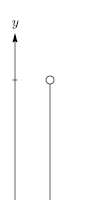Free fall is any motion of a body where gravity is the only force acting upon it, at least initially. These conditions produce an inertial trajectory so long as gravity remains the only force. Since this definition does not specify velocity, it also applies to objects initially moving upward. Since free fall in the absence of forces other than gravity produces weightlessness or "zero-g," sometimes any condition of weightlessness due to inertial motion is referred to as free-fall. This may also apply to weightlessness produced because the body is far from a gravitating body.
Although strict technical application of the definition excludes motion of an object subjected to other forces such as aerodynamic drag, in nontechnical usage, falling through an atmosphere without a deployed parachute, or lifting device, is also often referred to as free fall. The drag forces in such situations prevent them from producing full weightlessness, and thus a skydiver's "free fall" after reaching terminal velocity produces the sensation of the body's weight being supported on a cushion of air.
- A spacecraft (in space) with propulsion off (e.g. in a continuous orbit, or on a suborbital trajectory going up for some minutes, and then down).
- An object dropped at the top of a drop tube.
- An object thrown upwards or a person jumping off the ground at low speed (i.e. as long as air resistance is negligible in comparison to weight).
 .
.Since all objects fall at the same rate in the absence of other forces, objects and people will experience weightlessness in these situations.
Examples of objects not in free fall:
- Flying in an aircraft: there is also an additional force of lift.
- Standing on the ground: the gravitational force is counteracted by the normal force from the ground.
- Descending to the Earth using a parachute, which balances the force of gravity with an aerodynamic drag force (and with some parachutes, an additional lift force).
Uniform gravitational field without air resistance
This is the "textbook" case of the vertical motion of an object falling a small distance close to the surface of a planet. It is a good approximation in air as long as the force of gravity on the object is much greater than the force of air resistance, or equivalently the object's velocity is always much less than the terminal velocity (see below). is the initial velocity (m/s).
is the initial velocity (m/s). is the vertical velocity with respect to time (m/s).
is the vertical velocity with respect to time (m/s). is the initial altitude (m).
is the initial altitude (m). is the altitude with respect to time (m).
is the altitude with respect to time (m). is time elapsed (s).
is time elapsed (s). is the acceleration due to gravity (9.81 m/s2 near the surface of the earth).
is the acceleration due to gravity (9.81 m/s2 near the surface of the earth).












0 comments:
Post a Comment